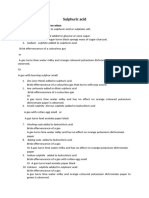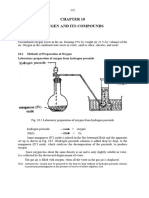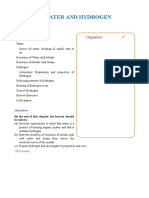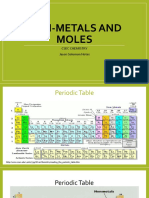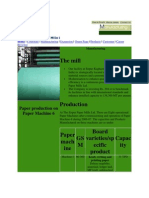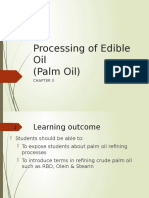Summary On Preparation of Gases
Summary On Preparation of Gases
Uploaded by
l6995212Copyright:
Available Formats
Summary On Preparation of Gases
Summary On Preparation of Gases
Uploaded by
l6995212Original Title
Copyright
Available Formats
Share this document
Did you find this document useful?
Is this content inappropriate?
Copyright:
Available Formats
Summary On Preparation of Gases
Summary On Preparation of Gases
Uploaded by
l6995212Copyright:
Available Formats
MASTER GUIDE 3 BY KIMUTAI SONOIYA
18 GASES PREPARABLE IN THE LABORATORY
1. OXYGEN
Oxygen
Oxygen exists freely in the atmosphere as a gas. Its chemical symbol is O. Two atoms of
oxygen combine to form a molecule with a chemical formula of O2. Oxygen is also found
combined with other elements such as hydrogen in water and metals in metal oxides. It
is the most active component in air.
⚗Practically Speaking🔊
📌
Laboratory preparation of oxygen
In the laboratory, oxygen
can be prepared by the
decomposition of hydrogen
peroxide using
manganese(IV) oxide as a
catalyst. Sodium peroxide
may also be reacted with
water to produce oxygen.
When potassium
permanganate (VII) is heated, oxygen is also produced.
Side notes
• The first few bubbles of oxygen are not collected because the gas is mixed with air
which was originally in the flask.
• Oxygen is slightly soluble in water and so it can be collected over water.
• Manganese (IV) oxide acts as a catalyst. A catalyst is a substance that alters the rate of a
reaction. In the absence of manganese (IV) oxide, the hydrogen peroxide can be
warmed to speed up the reaction.
Producing Oxygen: The Reactions
Hydrogen peroxide decomposes slowly to produce oxygen and water under normal
conditions. On adding manganese (IV) oxide the rate of decomposition is speeded up.
Manganese (IV) oxide is used as a catalyst in the decomposition of hydrogen peroxide.
Manganese (IV)oxide
Hydrogen peroxide → Oxygen (gas) + Water
CHEMISTRY IS NOT EASY AS YOU THINK! NO! IT IS MUCH EASIER THAN THAT.
FOR MORE CHEMISTRY GUIDES: kimutaisonoiya@gmail.com
MASTER GUIDE 3 BY KIMUTAI SONOIYA
Adding water to Solid Sodium Peroxide
Sodium peroxide + water → Sodium hydroxide + Oxygen
Heating Potassium Manganate (VII) (Potassium Permanganate)
Heat
Potassium Manganate (VII) → Potassium + Manganese (IV) oxide + Oxygen
Test for Oxygen
Oxygen relights a glowing splint. This is the test for oxygen
Properties of oxygen.
Oxygen is a colourless, odourless gas with a low boiling point of -183°C.
Uses of Oxygen
1. Air enriched with oxygen is used in hospitals by patients with breathing difficulties.
2. When mixed with helium it is used by mountain climbers and deep-sea divers.
3. Oxygen is used to burn fuels such as those used for propelling rockets.
4. A mixture of oxygen and acetylene burns to produce a very hot flame used in
welding and for cutting metals.
5. During steel making, oxygen is used to remove iron impurities.
6. Oxygen is used as one of the reactants in fuel cells.
CHEMISTRY IS NOT EASY AS YOU THINK! NO! IT IS MUCH EASIER THAN THAT.
FOR MORE CHEMISTRY GUIDES: kimutaisonoiya@gmail.com
MASTER GUIDE 3 BY KIMUTAI SONOIYA
2. HYDROGEN
Hydrogen
Hydrogen is the simplest and lightest element. It does not occur as a free element on
earth but exists in combined form. Examples of compounds containing hydrogen are
water, hydrocarbons and sugar.
Laboratory Preparation and properties of Hydrogen
Hydrogen gas is prepared in the laboratory by the reaction between dilute acids and
some metals. Dilute sulphuric acid and hydrochloric acid react with some metals to
liberate hydrogen gas. Zinc is the most suitable metal for the laboratory preparation of
hydrogen gas.
⚗Practically Speaking🔊
📌
The set up below can be used to prepare hydrogen gas in the laboratory.
If the reaction is slow, add a few
crystals of copper (II) sulphate. If
the gas is required dry, it should
be bubbled through
concentrated sulphuric acid and
collected by upward delivery.
Side notes
Hydrogen is insoluble in water, so it
is collected over water.
Hydrogen is less dense than air
and it can also be collected by
upward delivery. This method is
also called downward
displacement of air.
CHEMISTRY IS NOT EASY AS YOU THINK! NO! IT IS MUCH EASIER THAN THAT.
FOR MORE CHEMISTRY GUIDES: kimutaisonoiya@gmail.com
MASTER GUIDE 3 BY KIMUTAI SONOIYA
Copper (II) sulphate acts as a catalyst to speed up the reaction.
Dry hydrogen gas can be obtained by
passing wet hydrogen through anhydrous
calcium chloride in a U-tube or passing it
through concentrated sulphuric acid.
Observations and Discussion
When zinc granules are added to dilute hydrochloric acid there is effervescence and
hydrogen gas is evolved.
Zinc + Hydrochloric acid Zinc chloride + Hydrogen
Nitric acid is not used to prepare hydrogen gas because the hydrogen formed is oxidised
to water. However, very dilute nitric acid liberates hydrogen with magnesium metal.
Zinc is preferably used because it reacts moderately with dilute acids.
Potassium, sodium, lithium and calcium react explosively with dilute acids hence must
not be used. Magnesium could be used for the laboratory preparation of hydrogen but
it is expensive. Aluminium forms a protective layer of aluminium oxide, which should be
washed using concentrated hydrochloric acid before the metal can react with dilute
acids. Impure iron gives a mixture of gases including the bad smelling hydrogen sulphide
when it reacts with dilute acids.
Physical Properties of Hydrogen
Hydrogen is a colourless, odourless gas.
It is less dense than air and insoluble in water.
Hydrogen has no effect on litmus paper. It is neutral
Test for hydrogen
When mixed with air, hydrogen burns with a ‘pop’ sound. This is the test for hydrogen
gas. The intensity of the pop sound diminishes as the purity of hydrogen increases. Pure
hydrogen burns quietly with a blue flame. Hydrogen does not support combustion but it
burns in air.
Uses of Hydrogen
1. Hydrogen is used in the large-scale manufacture of ammonia in a process known as
the Haber process.
CHEMISTRY IS NOT EASY AS YOU THINK! NO! IT IS MUCH EASIER THAN THAT.
FOR MORE CHEMISTRY GUIDES: kimutaisonoiya@gmail.com
MASTER GUIDE 3 BY KIMUTAI SONOIYA
2. The gas is also used during the hardening of oils to form fats. When hydrogen is passed
through liquid oil in the presence of nickel catalyst, the oil takes up hydrogen and is
converted into fat. This process is called hydrogenation. It is used in the manufacture
of margarine.
3. Hydrogen is used in balloons because it is lighter than air. A balloon filled with
hydrogen floats in air. A light radio instrument can be connected to the balloon to
collect information from the atmosphere by meteorologists who study weather
conditions.
4. A mixture of hydrogen and oxygen burns to produce a very hot flame, the oxy-
hydrogen flame, which has a temperature of up to 2000°C. The flame is used in
welding and for cutting metals.
5. Hydrogen is used in rocket as fuel.
6. Hydrogen is used in the manufacture of hydrochloric acid.
7. Hydrogen is used as a fuel in fuel cells
CHEMISTRY IS NOT EASY AS YOU THINK! NO! IT IS MUCH EASIER THAN THAT.
FOR MORE CHEMISTRY GUIDES: kimutaisonoiya@gmail.com
MASTER GUIDE 3 BY KIMUTAI SONOIYA
3. CARBON (IV) OXIDE
Preparation of Carbon (IV) oxide
Carbon (IV) oxide is prepared by reacting calcium carbonate with dilute hydrochloric
acid.
Questions
1. What is observed in the conical flask containing the reactants?
When dilute hydrochloric acid is added to calcium carbonate, a vigorous
effervescence occurs releasing carbon (IV) oxide gas.
2. Write an equation for the reaction that occurs between calcium carbonate
and dilute hydrochloric acid.
Calcium carbonate + Dil. hydrochloric acid Calcium chloride + Carbon
(IV) oxide + Water
CaCO3(s) + 2HCl(aq) CaCl2(aq) + CO2(g) + H2O(l)
3. Explain the purpose of sodium hydrogen carbonate in this set-up.
The gas is passed through sodium hydrogen carbonate or water to remove traces of
hydrochloric acid fumes in the gas.
4. Explain why the gas is passed through concentrated suphuric acid.
When required dry, the gas is passed through concentrated sulphuric (VI) acid which
acts as a drying agent.
4. Suggest an alternative to concentrated sulphuric (VI) acid.
Anhydrous calcium chloride can be used in place of concentrated sulphuric (VI) acid
as a drying agent.
6. Which other reactants can be used to prepare carbon(IV) oxide? Is there an
exception?
CHEMISTRY IS NOT EASY AS YOU THINK! NO! IT IS MUCH EASIER THAN THAT.
FOR MORE CHEMISTRY GUIDES: kimutaisonoiya@gmail.com
MASTER GUIDE 3 BY KIMUTAI SONOIYA
Any other carbonate can be used with a suitable acid.
Dilute sulphuric (VI) acid SHOULD NOT BE reacted with calcium carbonate, barium
carbonate and lead carbonate. This is because insoluble sulphates produced form a
coating on the carbonates and prevent further reaction. For the same reasoned dilute
hydrochloric acid is not reacted with lead carbonate.
Properties of carbon (IV) oxide
Carbon (IV) oxide is a colourless, odourless gas. It is denser than air and neither burns
nor supports combustion. It is an acidic gas and dissolves in water to form weak carbonic
acid. As a test for the gas, it forms a white precipitate with calcium hydroxide.
Questions
1. Explain why carbon (IV) oxide is collected by downward delivery.
The gas is denser than air and this explains why it is collected by down ward delivery.
2. What deductions can be made about the properties of carbon (IV) oxide gas from
the following tests?
(a) Bubbling the gas through water containing the universal indicator.
The gas is acidic, and turns the universal indicator solution red.
(b) Inverting separate gas jars of carbon (IV) dioxide in troughs of water and sodium
hydroxide solution.
Carbon (IV) oxide gas slightly dissolves in water to form carbonic acid, a weak acid.
Carbon (IV) oxide + Water Carbonic acid
CO2(g) oxide + H2O(g) H2CO3(g)
Carbon (IV) oxide gas is acidic and readily reacts with sodium hydroxide solution to
form sodium carbonate.
Sodium hydroxide + Carbon (IV) oxide Sodium carbonate + Water
2NaOH(aq) + CO2(g) Na2CO3(aq) + H2O(l)
If the gas is in excess, a further reaction occurs that leads to the formation of sodium
hydrogen carbonate.
Sodium carbonate + Water + Carbon (IV) oxide Sodium hydrogen
carbonate
Na2CO3(aq) + H2O(l) + CO2(g) 2NaHCO3(aq)
CHEMISTRY IS NOT EASY AS YOU THINK! NO! IT IS MUCH EASIER THAN THAT.
FOR MORE CHEMISTRY GUIDES: kimutaisonoiya@gmail.com
MASTER GUIDE 3 BY KIMUTAI SONOIYA
(c)Inverting a gas jar full of carbon (IV) oxide over a candle flame as shown below.
Carbon (IV) oxide neither burns nor supports combustion. This is why the gas puts off a
burning candle.
1. Explain using equations, the change observed when carbon (IV) oxide is
bubbled through limewater until there is no further change.
When Carbon (IV) oxide is bubbled through calcium hydroxide for a short while, a white
precipitate is formed. The white precipitate is due to the formation of the insoluble
calcium carbonate. This is the confirmatory test for carbon (IV) oxide.
Calcium hydroxide + Carbon (IV) oxide Calcium carbonate + Water
Ca(OH)2(aq) + CO2(g) CaCO3(s) + H2O(l)
When the gas is passed through the mixture for a while the white precipitate dissolves
to form a colourless solution of calcium hydrogen carbonate.
Calcium carbonate + Water + Calcium (IV) oxide Calcium hydrogen
carbonate
CaCO3(s) + H2O(l) + CO2(g) Ca(HCO3)2(aq)
4. Write chemical equations for the reactions that take place when:
(a) Magnesium is burnt in carbon (IV) oxide gas.
Although the gas does not support combustion, burning magnesium continues to burn
in it to produce a white powder of magnesium oxide and black specks of carbon. The
burning magnesium produces a lot of heat that decomposes carbon (IV) oxide to carbon
and oxygen.
Magnesium + Carbon (IV) oxide Magnesium oxide + Carbon
2Mg(s) + CO2(g) 2MgO(s) + C(s)
The addition of dilute nitric (V) acid dissolves magnesium oxide leaving black specks of
carbon.
(b) Carbon (IV) oxide is reacted with sodium hydroxide solution for a few seconds.
2NaOH(aq) + CO2(g) Na2CO3(aq) + H2O(l)
CHEMISTRY IS NOT EASY AS YOU THINK! NO! IT IS MUCH EASIER THAN THAT.
FOR MORE CHEMISTRY GUIDES: kimutaisonoiya@gmail.com
MASTER GUIDE 3 BY KIMUTAI SONOIYA
Uses of Carbon (IV) oxide gas
1. Carbon (IV) oxide gas is used as a refrigerating agent for perishable goods.
This is because solid carbon (IV) oxide sublimes when heated, leaving no residue.
2. Carbon (IV) oxide is used to extinguish fires because it is non-flammable
and has a higher density than air therefore it forms a ‘blanket’ on fire cutting off
oxygen supply.
3. It is used in the manufacture of sodium carbonate in the Solvay process.
4. Carbon (IV) oxide is dissolved in water to make aerated drinks to add taste,
it is also used to make baking powder.
CHEMISTRY IS NOT EASY AS YOU THINK! NO! IT IS MUCH EASIER THAN THAT.
FOR MORE CHEMISTRY GUIDES: kimutaisonoiya@gmail.com
MASTER GUIDE 3 BY KIMUTAI SONOIYA
4. CARBON (II) OXIDE
Preparation of carbon (II) oxide
Carbon (II) oxide may be prepared by dehydrating methanoic acid using
concentrated sulphuric (VI) acid.
HCOOH(s) CO(g) + H2O(l)
Ethanedioic acid (oxalic acid) may be used in place of methanoic acid as shown
below.
CHEMISTRY IS NOT EASY AS YOU THINK! NO! IT IS MUCH EASIER THAN THAT.
FOR MORE CHEMISTRY GUIDES: kimutaisonoiya@gmail.com
MASTER GUIDE 3 BY KIMUTAI SONOIYA
The gaseous mixture should be passed through a concentrated solution of sodium
hydroxide to remove the carbon (IV) oxide, CO2. The gas may also be prepared by
passing Carbon (IV) oxide over heated charcoal as shown in the set up below.
Carbon (IV) oxide + Carbon Carbon (II) oxide
CO2(g) + C(s) 2CO(g)
CHEMISTRY IS NOT EASY AS YOU THINK! NO! IT IS MUCH EASIER THAN THAT.
FOR MORE CHEMISTRY GUIDES: kimutaisonoiya@gmail.com
MASTER GUIDE 3 BY KIMUTAI SONOIYA
5. NITROGEN
Laboratory preparation of nitrogen.
Nitrogen can be prepared by
heating a mixture of sodium nitrite
and ammonium chloride
Ammonium chloride and sodium
nitrite react to form ammonium
nitrite and sodium chloride.
Ammonium nitrite is unstable and
decomposes to form nitrogen and
steam.
Ammonium chloride and sodium nitrite react to form ammonium nitrite and sodium
chloride.
NaNO2(aq) + NH4Cl(aq) NH4NO2(aq) + NaCl(aq)
Ammonium nitrite is unstable and decomposes to form nitrogen and steam.
NH4NO2(aq) N2(g) + 2H2O(g)
Side Notes
Nitrogen is slightly soluble in water hence it is collected over water.
Nitrogen obtained from this reaction is less dense than that isolated from air because
it does not contain impurities.
Properties of nitrogen.
Nitrogen is a colourless, oduorless and tasteless gas that is slightly less dense than air. The
boiling point is –96°C. It is slightly soluble in water.
Nitrogen neither burns nor supports combustion. It is neutral and has no effect on moist
litmus paper and does not react readily with other elements.
Nitrogen gas does not react with sulphur and phosphorus. It is chemically unreactive
under ordinary conditions. A molecule of nitrogen has a triple covalent bond, N≡N,
which is very strong and requires a lot of energy to break. The presence of nitrogen in
the air slows down the rate of burning due to its inert nature.
At higher temperatures, it reacts with metals in group I and II to form their nitrides.
3Mg(s) + N2(g) Mg3N2(s)
CHEMISTRY IS NOT EASY AS YOU THINK! NO! IT IS MUCH EASIER THAN THAT.
FOR MORE CHEMISTRY GUIDES: kimutaisonoiya@gmail.com
MASTER GUIDE 3 BY KIMUTAI SONOIYA
When some water is added to the nitride, ammonia gas and magnesium
hydroxide are formed.
Mg3N2(s) + 6H2O(l) 3Mg(OH)2(aq) + 2NH3(g)
Nitrogen is distinguished from other gases by its negative results with all the tests used
to identify common gases.
Uses of Nitrogen
• Manufacture of ammonia in the Haber process.
• In light bulbs because of its inert nature it cannot react with the hot filament of the
bulb.
As a refrigerant, e.g., in the storage of semen for artificial insemination.
CHEMISTRY IS NOT EASY AS YOU THINK! NO! IT IS MUCH EASIER THAN THAT.
FOR MORE CHEMISTRY GUIDES: kimutaisonoiya@gmail.com
MASTER GUIDE 3 BY KIMUTAI SONOIYA
6. NITROGEN (I) OXIDE
Laboratory preparation of nitrogen (I) oxide.
Nitrogen (I) oxide can be prepared in the
laboratory by heating ammonium nitrate.
Ammonium nitrate melts and decomposes on
heating to form nitrogen(I) oxide and steam.
NH4NO3(s) N2O(g) + 2H2O(g)
Properties of nitrogen (I) oxide.
Nitrogen(I) oxide is a colourless gas with a pleasant smell. The gas causes insensitivity
when inhaled.
It is slightly less dense than air. It is fairly soluble in cold water but insoluble in warm
water. For this reason it is usually collected over warm water.
Nitrogen(I) oxide gas is not reactive at room temperature. However, it relights a
glowing splint. The heat from the glowing splint dissociates the gas producing nitrogen
and oxygen gas. The oxygen produced relights the splint.
When nitrogen(I) oxide is passed
over heated copper, a black
residue of copper (II) oxide and
nitrogen are formed.
Cu(s) + N2O(g) CuO(s)
+ N2(g)
Sulphur burns brilliantly in nitrogen(I) oxide to form sulphur(IV) oxide and nitrogen.
S(s) + N2O(g) SO(s) + N2(g)
Uses of Nitrogen(I) Oxide
• It was formerly used as an anaesthetic during dental surgery. Patients recovering from
it laugh hysterically hence the name ‘laughing gas’.
• It is used as a food additive.
• It is used as an oxidiser in racing car engines and rockets.
• It is used to produce flames for analytical work
CHEMISTRY IS NOT EASY AS YOU THINK! NO! IT IS MUCH EASIER THAN THAT.
FOR MORE CHEMISTRY GUIDES: kimutaisonoiya@gmail.com
MASTER GUIDE 3 BY KIMUTAI SONOIYA
7. NITROGEN (II) OXIDE
Laboratory preparation of nitrogen (II) oxide
Nitrogen(II) oxide is produced when copper and dilute nitric(V) acid react.
3Cu(s) + 8HNO3(aq) 3Cu(NO3)2(aq) + 4H2O(1) + 2NO(g)
Nitrogen(II) oxide is oxidised by oxygen in the
flask to form red-brown fumes of nitrogen(IV)
oxide.
2NO(g) + O2 (g) 2NO2 (g)
The fumes gradually disappear as the air in the
flask is exhausted. Nitrogen(IV) oxide formed
dissolves in the water in the trough.
Properties of Nitrogen(II) Oxide (Nitrogen Monoxide)
Nitrogen(II) oxide is a colourless gas. It is slightly soluble in water and has no effect on
moist litmus paper.
Nitrogen(II) oxide neither burns nor supports combustion. However, it oxidises some
strongly heated elements to their oxides.
Magnesium continues to burn in nitrogen(II) oxide. The heat produced decomposes the
gas into nitrogen and oxygen. The oxygen produced enables the hot element to
continue burning.
2Mg(s) + 2NO(g) 2MgO(s) + N2(g)
2Cu(s) + 2NO(g) 2CuO(s) + N2(g)
P4(s) + 10NO(g) 2P2O5(g) 5N2(g)
Iron(II) sulphate solution turns dark brown when nitrogen(II) oxide is bubbled through it.
This is due to the formation of iron(II) sulphate – nitrogen(II) oxide complex, FeSO4.NO.
FeSO4(aq) + NO(g) FeSO4.NO (aq)
Pale gree dark brown
When exposed to air, nitrogen(II) oxide is readily oxidised by oxygen to form red brown
fumes of nitrogen(IV) oxide. This reaction is used as the test for nitrogen(II) oxide.
CHEMISTRY IS NOT EASY AS YOU THINK! NO! IT IS MUCH EASIER THAN THAT.
FOR MORE CHEMISTRY GUIDES: kimutaisonoiya@gmail.com
MASTER GUIDE 3 BY KIMUTAI SONOIYA
8. NITROGEN (IV) OXIDE
Laboratory Preparation of nitrogen (IV) oxide
Nitrogen (IV) Oxide can be prepared by the reaction of concentrated nitric(V) acid on
copper turnings.
Cu(s) + 4HNO3(l) Cu(NO3)2(aq) + 2NO2(g) + 2H2O(l)
Nitrogen(IV) oxide may also be prepared by
thermal decomposition of nitrates of metals
below sodium in the reactivity series. However,
lead(II) nitrate is the most suitable because it is
not hydrated.
When concentrated nitric(V) acid is added to
copper turnings, a vigorous reaction takes
place and red-brown fumes of nitrogen(IV)
oxide are evolved.
Cu(s) + 4HNO3(l) Cu(NO3)2(aq) + 2NO2(g) + 2H2O(l)
Nitrogen(IV) oxide may also be prepared by thermal decomposition of nitrates of metals
below sodium in the reactivity series. However, lead(II) nitrate is the most suitable
because it is not hydrated.
When heated, lead(II) nitrate decomposes to form lead(II) oxide, nitrogen(IV) oxide and
oxygen. The set up below can be used to prepare nitrogen(IV) oxide from metal nitrates.
2Pb(NO3)2(s) 2PbO(s) + 4NO2(g) + O2(g)
The gases produced are passed through a U-tube surrounded by ice-cold water. On
cooling, nitrogen(IV) oxide condenses to form dinitrogen tetraoxide, N2O4, which is a
pale-yellow liquid. Oxygen gas is collected over water.
𝑐𝑜𝑜𝑙𝑖𝑛𝑔
2NO2(g) → N2O4 (l)
Reddish-brown pale-yellow
CHEMISTRY IS NOT EASY AS YOU THINK! NO! IT IS MUCH EASIER THAN THAT.
FOR MORE CHEMISTRY GUIDES: kimutaisonoiya@gmail.com
MASTER GUIDE 3 BY KIMUTAI SONOIYA
Uses of Nitrogen (IV) Oxide
• In the manufacture of nitric(V) acid.
• As an intermediate in the manufacture of explosives, nylon and plastics.
• As an oxidising agent in the lead chamber during the manufacture of sulphuric (VI)
acid.
CHEMISTRY IS NOT EASY AS YOU THINK! NO! IT IS MUCH EASIER THAN THAT.
FOR MORE CHEMISTRY GUIDES: kimutaisonoiya@gmail.com
MASTER GUIDE 3 BY KIMUTAI SONOIYA
9. AMMONIA
Ammonia
Ammonia, NH3, is a compound of nitrogen and hydrogen. It is a gas at room temperature.
Laboratory preparation of Ammonia
Ammonia is prepared in the laboratory by heating a
mixture of an ammonium salt and an alkali.
Ammonia is a more volatile base and is displaced by
a less volatile base, e.g., NaOH, KOH and Ca(OH)2.
Ca(OH2)(s) + 2NH4Cl(s) CaCl2(s) +
2H2O(l) + 2NH3(g)
The ionic equation for the reaction is:
NH4+(aq) + OH- (aq) NH3 (g) +
H2O (l)
Calcium oxide (quicklime) is used as a drying
agent. This is because ammonia reacts with the
other common drying agents.
Side Notes
The flask containing the mixture is set in a slanting position to prevent water which
condenses on the cooler parts of the apparatus, from running back into the flask and
causing it to crack.
A moist litmus paper placed at the mouth of the gas jar turns blue indicating the gas
jar is full of ammonia.
Calcium oxide (quicklime) is used as a drying agent. This is because ammonia reacts
with the other common drying agents.
Concentrated sulphuric (VI) acid reacts with ammonia to form ammonium
sulphate.
2NH3(g) + H2SO4(l) (NH4)2SO4(aq)
Calcium chloride forms a complex compound with ammonia.
CaCl2(s) + 4NH3(g) CaCl2.4NH3(s)
Ca(OH2)(s) + 2NH4Cl(s) CaCl2(s) + 2H2O(l) + 2NH3(g)
Properties of Ammonia
Ammonia is a colourless gas, with a characteristic choking pungent smell. It is less dense
than air and therefore it is collected by upward delivery. The gas is very soluble in water.
CHEMISTRY IS NOT EASY AS YOU THINK! NO! IT IS MUCH EASIER THAN THAT.
FOR MORE CHEMISTRY GUIDES: kimutaisonoiya@gmail.com
MASTER GUIDE 3 BY KIMUTAI SONOIYA
Ammonia turns moist red litmus paper blue showing that it is alkaline. This is the
confirmatory test for ammonia.
When a glass rod dipped in concentrated hydrochloric acid is brought to the mouth of
a gas jar full of ammonia, hydrogen chloride fumes react with ammonia to form white
fumes of ammonium chloride.
NH3(g) + HCl(g) NH4Cl(g)
Uses of Ammonia
• As a fertiliser.
• Manufacture of nitrogenous fertilisers.
• As a refrigerant, e.g., in large scale refrigerating plants such as ships and
warehouses.
• Softening water.
• Removal of greasy stains.
• Manufacture of hydrazine that is used as rocket fuel.
CHEMISTRY IS NOT EASY AS YOU THINK! NO! IT IS MUCH EASIER THAN THAT.
FOR MORE CHEMISTRY GUIDES: kimutaisonoiya@gmail.com
MASTER GUIDE 3 BY KIMUTAI SONOIYA
10. SULPHUR (IV) OXIDE
Laboratory preparation of sulphur (IV) oxide.
Sulphur(IV) oxide is prepared in the laboratory by the action of dilute hydrochloric acid
on a suitable sulphite such as sodium sulphite.
Na2SO3(s) + 2HCl(aq) SO2(g) + 2NaCl(aq) + H2O(l)
The gas may also be prepared by the action of concentrated sulphuric(VI) acid on
copper turnings. The reaction should be carried out in a fume cupboard.
Cu(s) + 2H2SO4(aq) SO2(g) + 2H2O(l) + CuSO4(aq)
Sulphur(IV) oxide is dried by passing it through concentrated sulphuric(IV) acid and
collected by downward delivery. The gas jar is confirmed to be full of the gas when the
paper soaked in orange potassium chromate(VI) turns green.
Physical Properties of Sulphur(IV) Oxide
Sulphur(IV) oxide is a colourless poisonous gas with a characteristic irritating, and choking
smell.
It has a boiling point of –10°C and is readily liquefied under pressure.
Discussion Questions
1. Give a reason why sulphur(IV) oxide is collected by downward delivery.
It is denser than air, hence can be collected by downward delivery.
2. Explain the observation made when a test-tube full of sulphur(IV) oxide is inverted
in a trough of water.
When a test-tube full of the gas is inverted in a trough of water, the water level
rises rapidly inside the test-tube. This shows that the gas is soluble in water.
CHEMISTRY IS NOT EASY AS YOU THINK! NO! IT IS MUCH EASIER THAN THAT.
FOR MORE CHEMISTRY GUIDES: kimutaisonoiya@gmail.com
MASTER GUIDE 3 BY KIMUTAI SONOIYA
3. Explain the observation made when:
(a) A damp litmus paper was dropped into a test-tube containing sulphur(IV)
oxide gas.
When a moist blue litmus paper is dropped into a test-tube containing sulphur(IV)
oxide, it turns red showing that the gas is acidic. The gas has no effect on dry
litmus. The solution of the gas in water is sulphuric(IV) acid. This is a weak dibasic
acid.
SO2(g) + H2O(l) H2SO3(aq)
The acid is responsible for the change in colour of the moist litmus.
(a) Sodium hydroxide solution is added to sulphur(IV) oxide.
When sodium hydroxide solution is added to sulphur(IV) oxide gas, neutralisation
occurs. The sulphuric(IV) acid formed reacts with sodium hydroxide forming a salt
and water. During the reaction between the acid and sodium hydroxide, two
types of salts are formed, a normal and an acid salt.
CHEMISTRY IS NOT EASY AS YOU THINK! NO! IT IS MUCH EASIER THAN THAT.
FOR MORE CHEMISTRY GUIDES: kimutaisonoiya@gmail.com
MASTER GUIDE 3 BY KIMUTAI SONOIYA
11. SULPHUR (VI) OXIDE
Preparation of Sulphur (VI) Oxide (SO3)
In the laboratory, sulphur(VI) oxide is prepared by reacting sulphur(IV) oxide with oxygen
in the presence of a platinum catalyst.
Lab Preparation of Sulphur Trioxide, SO3
Equation for the reaction taking place,
2SO2(g)+ O2(g) 2SO3(s)
Other Methods
Decomposing of sodium hydrogen sulphate.
Discussion Questions
1. State the purpose of the following in the set up.
(a) Concentrated sulphuric(VI) acid.
Sulphur(IV) oxide and oxygen gases are dried by passing them through
concentrated sulphuric(VI) acid
(b) Freezing salt ice mixture.
The sulphur(VI) oxide is cooled by the freezing salt-ice mixture and it solidifies.
(c) Anhydrous calcium chloride.
CHEMISTRY IS NOT EASY AS YOU THINK! NO! IT IS MUCH EASIER THAN THAT.
FOR MORE CHEMISTRY GUIDES: kimutaisonoiya@gmail.com
MASTER GUIDE 3 BY KIMUTAI SONOIYA
Since sulphur(VI) oxide is deliquescent, calcium chloride is used to keep it free
from moisture
2. Write an equation for the reaction that takes place in the combustion tube.
2SO2(g)+ O2(g) 2SO3(s)
3. Comment on the method of collection of sulphur(VI) oxide.
The sulphur(VI) oxide is cooled by the freezing salt-ice mixture and it solidifies.
This allows it to be collected as illustrated.
Uses of Sulphur(VI) Oxide
Sulphur(VI) oxide is used:
• As a major raw material in the large scale manufacture of sulphuric(VI) acid.
• To make calcium hydrogen sulphite, Ca(HSO3)2, used to bleach wood pulp in the
manufacture of paper.
• As a fumigant.
• As a preservative in jam and fruit juices.
CHEMISTRY IS NOT EASY AS YOU THINK! NO! IT IS MUCH EASIER THAN THAT.
FOR MORE CHEMISTRY GUIDES: kimutaisonoiya@gmail.com
MASTER GUIDE 3 BY KIMUTAI SONOIYA
12. HYDROGEN SULPHIDE
Hydrogen Sulphide (H2S)
Hydrogen sulphide is a gaseous compound of sulphur which is very poisonous. It occurs
naturally in some deposits mixed with natural gas.
Preparation and properties of hydrogen sulphide
The set-up below can be used to prepare hydrogen sulphide.
.
Hydrogen sulphide is formed when dilute hydrochloric acid is added to iron(II) sulphide.
FeS(s) + 2HCl(aq) FeCl2(aq) + H2S(g)
However, any metal sulphide, and dilute acid can be used to prepare hydrogen sulphide
gas.
The gas is collected over warm water since it dissolves in cold water.
The gas can be dried by passing it through a U-tube packed with anyhydrous calcium
chloride.
The gas cannot be dried using concentrated sulphuric(VI) acid because it would be
oxidised to sulphur.
3H2S(g) + H2SO4(l) 4S(s) + 4H2O(l)
Physical properties of hydrogen sulphide
Hydrogen sulphide is a colourless gas with a characteristic smell of rotten eggs. It is very
poisonous. It is slightly soluble in cold water. It is denser than air.
CHEMISTRY IS NOT EASY AS YOU THINK! NO! IT IS MUCH EASIER THAN THAT.
FOR MORE CHEMISTRY GUIDES: kimutaisonoiya@gmail.com
MASTER GUIDE 3 BY KIMUTAI SONOIYA
13. CHLORINE
CHEMISTRY IS NOT EASY AS YOU THINK! NO! IT IS MUCH EASIER THAN THAT.
FOR MORE CHEMISTRY GUIDES: kimutaisonoiya@gmail.com
MASTER GUIDE 3 BY KIMUTAI SONOIYA
CHEMISTRY IS NOT EASY AS YOU THINK! NO! IT IS MUCH EASIER THAN THAT.
FOR MORE CHEMISTRY GUIDES: kimutaisonoiya@gmail.com
MASTER GUIDE 3 BY KIMUTAI SONOIYA
14. HYDROGEN CHLORIDE
CHEMISTRY IS NOT EASY AS YOU THINK! NO! IT IS MUCH EASIER THAN THAT.
FOR MORE CHEMISTRY GUIDES: kimutaisonoiya@gmail.com
MASTER GUIDE 3 BY KIMUTAI SONOIYA
15. METHANE 16. ETHANE
Laboratory preparation of methane and ethane
In the laboratory, alkanes are prepared by the reaction between sodalime (mixture of
sodium hydroxide and calcium oxide) and an appropriate alkanoate.
When a mixture of sodium ethanoate and soda lime (sodium hydroxide and calcium
oxide) is heated, methane gas is obtained.
Similarly, when a mixture of sodium propanoate, and soda lime is heated ethane gas is
obtained.
Physical Properties
Methane is a non-poisonous, colourless gas.
It is slightly soluble in water and hence can be collected over water. However, it is quite
soluble in organic solvents such as ethanol and tetrachloromethane. It is less dense than
air.
Uses of Alkanes
1. Gaseous alkanes such as methane, propane and butane are used in homes as fuels.
2. They are used in the manufacture of carbon black which is a component of printers’
ink, and paint.
3. They are used in the manufacture of methanol, methanal, and chloromethane which
are useful industrial chemicals.
4. As a source of hydrogen during the cracking process.
CHEMISTRY IS NOT EASY AS YOU THINK! NO! IT IS MUCH EASIER THAN THAT.
FOR MORE CHEMISTRY GUIDES: kimutaisonoiya@gmail.com
MASTER GUIDE 3 BY KIMUTAI SONOIYA
17. ETHENE
Laboratory preparation of ethyne
Alkenes can be prepared by dehydrating their corresponding alkanols using
concentrated sulphuric acid or aluminum oxide.
For example, ethene can be prepared by dehydrating ethanol using concentrated
sulphuric acid or aluminium oxide. The mixture of ethanol and concentrated sulphuric
acid or aluminum oxide must be heated to a temperature of 170°C.
1. Dehydratingethanol with concentrated sulphuric acid.
The ratio of ethanol to concentrated sulphuric acid is 1:2 respectively.
2. Dehydrating ethanol with aluminum oxide
Discussion Questions.
1. Write an equation for the reaction between ethanol and concentrated sulphuric
acid.
The removal of water molecules from ethanol is a dehydration process. Conc. sulphuric
acid is a dehydrating agent.
2. What is the purpose of the broken porcelain in the reaction flask?
CHEMISTRY IS NOT EASY AS YOU THINK! NO! IT IS MUCH EASIER THAN THAT.
FOR MORE CHEMISTRY GUIDES: kimutaisonoiya@gmail.com
MASTER GUIDE 3 BY KIMUTAI SONOIYA
Broken porcelain or sand is used to prevent bumping which may result in cracking of the
flask.
3. Why was sodium hydroxide solution used in the experiment?
The gas produced is passed through sodium hydroxide to remove sulphur(IV) oxide and
carbon(IV) oxide which are formed when concentrated sulphuric acid and ethanol
decompose respectively due to heat.
4. What property of ethene gas enables one to use the above method of collecting it?
Ethene is slightly soluble in water hence is collected over water.
5. Why is it preferable to use a sand bath instead of heating the round-bottomed flask
directly?
To prevent bumping which may result in cracking of the flask.
6. Explain how aluminium oxide is used to prepare ethene.
The aluminium oxide acts both as a catalyst as well as a dehydrating agent.
Physical Properties
Ethene is a colourless and oduorless gas.
It is slightly soluble in water hence is collected over water.
The solubility of alkenes decreases with increase in molecular mass. Ethene is very
soluble in organic solvents such as methylbenzene, and tetrachloromethane.
The melting point, and boiling points of alkenes generally increase with increase
in the number of carbon atoms due to an increase in inter-molecular forces,
hence, high boiling and melting points.
Tests for Alkenes
The addition reactions of alkenes with bromine water, acidified potassium manganate
(VII) or acidified potassium(VI) dichromate can be used to test for the presence of a
double bond.
Uses of Alkenes
1. In the manufacture of plastics.
2. In the manufacture of ethanol through hydrolysis reactions.
3. In the ripening of fruits (ethene).
4. In the manufacture of detergents.
5. In the laboratory preparation of ethan –1,2 –diol (glycol) which is used as in coolant
(especially as an engine coolant).
CHEMISTRY IS NOT EASY AS YOU THINK! NO! IT IS MUCH EASIER THAN THAT.
FOR MORE CHEMISTRY GUIDES: kimutaisonoiya@gmail.com
MASTER GUIDE 3 BY KIMUTAI SONOIYA
18. ETHYNE
Laboratory Preparation of Ethyne
Calcium carbide reacts with water at room temperature to form ethyne and
calcium hydroxide.
CaC2(s) + 2H2O(l) → C2H2(g) + Ca(OH)2(aq)
A layer of sand is placed at the base of the flask because the reaction is highly
exothermic. The sand absorbs the excess heat and therefore prevents the flask
from breaking.
The flask must be dry before the start of the experiment to avoid formation of the
gas before the set-up is complete.
Physical Properties
Ethyne is a colourless gas and has a pleasant smell when pure. It is slightly soluble in water,
and therefore can be collected over water. The solubility of alkynes is higher in non-polar
solvents. The table below gives some properties of alkynes.
Test for Alkynes
The test for alkynes is similar to the tests for alkenes in which the oxidising agents are
decolourised. However, the reaction is faster in alkynes than in alkenes.
Uses of Alkynes
1. They are used in the industrial manufacture of compounds such as adhesives, and
plastics.
2. In the manufacture of synthetic fibres such as rayon.
3. In the production of important chemical reagents and solvents, in which it is used as
a starting material.
4. They are used in the oxy-acetylene flame which is used for welding, and cutting
metals.
CHEMISTRY IS NOT EASY AS YOU THINK! NO! IT IS MUCH EASIER THAN THAT.
FOR MORE CHEMISTRY GUIDES: kimutaisonoiya@gmail.com
You might also like
- Astm B117-18 PDFDocument12 pagesAstm B117-18 PDFHUGO JOSÉ MONTERROZA ARRIETA100% (8)
- GUIDE Group Exercise #11: Problem-Solving PathDocument4 pagesGUIDE Group Exercise #11: Problem-Solving Pathnicole100% (1)
- Folio Chemistry F4 (Manufactured Substances in Industry)Document31 pagesFolio Chemistry F4 (Manufactured Substances in Industry)JackOss93No ratings yet
- IGCSE Chemistry - Oxygen, Hydrogen and Carbon DioxideDocument15 pagesIGCSE Chemistry - Oxygen, Hydrogen and Carbon DioxideChemistryKlipz75% (4)
- Diy Organic Beauty RecipesDocument198 pagesDiy Organic Beauty RecipesElla Allerton100% (11)
- Chemistry Form 2 Notes PDFDocument122 pagesChemistry Form 2 Notes PDFGeorge SombeNo ratings yet
- Year 10 Chemistry Notes On Sulfur and Sulfuric AcidDocument5 pagesYear 10 Chemistry Notes On Sulfur and Sulfuric Acidraghavmathur639No ratings yet
- NON-METALS (Trple) (2) 4Document14 pagesNON-METALS (Trple) (2) 4candy lebotseNo ratings yet
- The Air, Oxygen, and Co2Document9 pagesThe Air, Oxygen, and Co2osmantayfunsel2008No ratings yet
- 06 HydrogenDocument7 pages06 HydrogenJainil PanchalNo ratings yet
- Sulphuric Acid All QuestionsDocument5 pagesSulphuric Acid All QuestionsmoseenabanurmNo ratings yet
- Worksheet 5 and 6Document5 pagesWorksheet 5 and 6swatim280No ratings yet
- selfstudys_com_file (11)Document14 pagesselfstudys_com_file (11)saptarshinandi24No ratings yet
- Class X Sulphuric AcidDocument3 pagesClass X Sulphuric AcidvartikasinghNo ratings yet
- All Reactions - PadhleDocument18 pagesAll Reactions - Padhlerakshitham603No ratings yet
- a3a2c5a2 1f08 429c 8f03 b17c5ad01c94 S2 Chemistry Notes Water and Hydrogen 2020Document13 pagesa3a2c5a2 1f08 429c 8f03 b17c5ad01c94 S2 Chemistry Notes Water and Hydrogen 2020pakistanpower196No ratings yet
- OxygenDocument5 pagesOxygenKaavya Saraswathi SubramanianNo ratings yet
- Q1. Write A Brief Note On OxygenDocument3 pagesQ1. Write A Brief Note On OxygenRonnith NandyNo ratings yet
- Science Class 8Document4 pagesScience Class 8Shoaib AhmedNo ratings yet
- Production of Sulfuric Acid PDFDocument70 pagesProduction of Sulfuric Acid PDFزهراء عادل عبد الزهرة إسماعيلNo ratings yet
- Hydrogen - Notes & Q - ADocument15 pagesHydrogen - Notes & Q - AYOGESHNo ratings yet
- Non MetalsDocument34 pagesNon Metalsireen2005angeloNo ratings yet
- Chemical Reactions of Group IV Elements (3) CompressedDocument9 pagesChemical Reactions of Group IV Elements (3) CompressedTahera McsweenNo ratings yet
- Cha 10newDocument14 pagesCha 10newTun Lin AungNo ratings yet
- Unit 7 Hydrogen(notes)Document12 pagesUnit 7 Hydrogen(notes)shineforgodjesusNo ratings yet
- Chemistry Folio Form 4 2013Document17 pagesChemistry Folio Form 4 2013Megat AshmannNo ratings yet
- Preparation of HydrogenDocument9 pagesPreparation of HydrogenDavies Masumba67% (3)
- Kimia Chapter 9Document35 pagesKimia Chapter 9Mohammad AmirNo ratings yet
- Properties of Selected Compounds (Group IV-Vi)Document23 pagesProperties of Selected Compounds (Group IV-Vi)Oluwamayowa Ajibola-ajoNo ratings yet
- 5333 Oxygen and Its CompoundsDocument5 pages5333 Oxygen and Its Compoundsbilldanit4fitzNo ratings yet
- Std10 Science EM 3 PDFDocument90 pagesStd10 Science EM 3 PDFVivek AnandanNo ratings yet
- Hydrogen and Its CompoundsDocument14 pagesHydrogen and Its Compoundsenochobaro2No ratings yet
- IGCSE Chemistry Oxygen Hydrogen and Carbon DioxideDocument15 pagesIGCSE Chemistry Oxygen Hydrogen and Carbon DioxideS M AkashNo ratings yet
- 5.0non MetalsDocument27 pages5.0non MetalsakeemNo ratings yet
- Chemistry Chapter 6 NotesDocument4 pagesChemistry Chapter 6 Notesmeenakshikumawat601No ratings yet
- Sulphuric AcidDocument3 pagesSulphuric AcidafeequewNo ratings yet
- Chapter 9 Folio: Manufactured Substances in Industry.: ChemistryDocument15 pagesChapter 9 Folio: Manufactured Substances in Industry.: ChemistryFaizul IzhamNo ratings yet
- Non MetalDocument54 pagesNon Metalchinyegaamadi2022No ratings yet
- Hydrogen CH 7 202122 ChemDocument19 pagesHydrogen CH 7 202122 Chembhavyakapadia149No ratings yet
- Chemistry Holidays Assignment: Form 4Document39 pagesChemistry Holidays Assignment: Form 4Hafiz HakimiNo ratings yet
- Hydrogen Is The of The Periodic Table.: First ElementDocument5 pagesHydrogen Is The of The Periodic Table.: First Elementnofodic311No ratings yet
- Industrial Processes For ChemistryDocument12 pagesIndustrial Processes For Chemistryncaroline443No ratings yet
- 3 BodyPartDocument70 pages3 BodyPartAhmed ThaerNo ratings yet
- Chemistry-Folio Form 4Document45 pagesChemistry-Folio Form 4Ahmad Izzat Mohd HanafiNo ratings yet
- 3RD TERM SCHEME OF WORK Oxygen Note.Document12 pages3RD TERM SCHEME OF WORK Oxygen Note.stephaniebhadaNo ratings yet
- IGCSE Chemistry Section 2 Lesson 3Document62 pagesIGCSE Chemistry Section 2 Lesson 3Miftah ukhrowi DamanikNo ratings yet
- Chemistry (Assertion Reason Questions)Document2 pagesChemistry (Assertion Reason Questions)itsmekeshavmongiaNo ratings yet
- 1.5 Water and Hydrogen-1Document15 pages1.5 Water and Hydrogen-1Festus NanokNo ratings yet
- Folio ChemistryDocument32 pagesFolio Chemistrybella21893No ratings yet
- Viva Questions and AnswersDocument6 pagesViva Questions and Answerssrihrithik47No ratings yet
- 2122 Mid-Year Exam Revision NotesDocument7 pages2122 Mid-Year Exam Revision NotesUncomfortsNo ratings yet
- Sulphuric AcidDocument22 pagesSulphuric AcidNurain Nasuha Tajul ArafatNo ratings yet
- 3067Document3 pages3067KaviayNo ratings yet
- Chemistry 2Document51 pagesChemistry 2TUMUSIIME INNOCENTNo ratings yet
- Chemistry Revision Notes For O LevelDocument28 pagesChemistry Revision Notes For O LevelshinNo ratings yet
- Oxygen and HydrogenDocument7 pagesOxygen and HydrogenEve GayleNo ratings yet
- Chemistry Form 4 Solihin Full 1Document24 pagesChemistry Form 4 Solihin Full 1Aiman ShuhaimiNo ratings yet
- Lesson 2 Non-Metals and Moles G11Document61 pagesLesson 2 Non-Metals and Moles G11Jodell CampbellNo ratings yet
- A System of Instruction in the Practical Use of the BlowpipeFrom EverandA System of Instruction in the Practical Use of the BlowpipeNo ratings yet
- A System of Instruction in the Practical Use of the Blowpipe: Being A Graduated Course Of Analysis For The Use Of Students And All Those Engaged In The Examination Of Metallic CombinationsFrom EverandA System of Instruction in the Practical Use of the Blowpipe: Being A Graduated Course Of Analysis For The Use Of Students And All Those Engaged In The Examination Of Metallic CombinationsNo ratings yet
- Fun Facts about Hydrogen : Chemistry for Kids The Element Series | Children's Chemistry BooksFrom EverandFun Facts about Hydrogen : Chemistry for Kids The Element Series | Children's Chemistry BooksNo ratings yet
- VDZ-Onlinecourse 6 7 enDocument22 pagesVDZ-Onlinecourse 6 7 enAnonymous iI88LtNo ratings yet
- Thesis 2021Document57 pagesThesis 2021ManishNo ratings yet
- Water Technology Short NotesDocument12 pagesWater Technology Short NotesKARTHI KRISHNANo ratings yet
- Pe Ts 417 154 A001 (Tech Spec For CDS) Rev 0 1590744768Document117 pagesPe Ts 417 154 A001 (Tech Spec For CDS) Rev 0 1590744768BhaskarNo ratings yet
- Viva ChemDocument21 pagesViva Chemnitinchandra834No ratings yet
- Sirpur Paper ManufacturingDocument3 pagesSirpur Paper ManufacturingMohammed Abdul JabbarNo ratings yet
- Mil-Dtl-248 TNTDocument20 pagesMil-Dtl-248 TNTCorina RomanNo ratings yet
- Important Science Class 10Document191 pagesImportant Science Class 10Karan KumarNo ratings yet
- Group 1-ADocument14 pagesGroup 1-AShivam GuptaNo ratings yet
- Files-3-Lecture Notes CHEM-303 (Classification Tests)Document56 pagesFiles-3-Lecture Notes CHEM-303 (Classification Tests)mmiliyasNo ratings yet
- Processing of Edible Oil (Palm Oil)Document33 pagesProcessing of Edible Oil (Palm Oil)Salihah AbdullahNo ratings yet
- 10 ScienceDocument204 pages10 ScienceKalpna RaniNo ratings yet
- Aluminum Air Battery ActivityDocument4 pagesAluminum Air Battery ActivityLuis Gustavo PachecoNo ratings yet
- Design Database ChE 193 Plant DesignDocument3 pagesDesign Database ChE 193 Plant DesignSnow DropNo ratings yet
- TUTORIAL CHAPTER 5-Volumetric Analysis 2017Document4 pagesTUTORIAL CHAPTER 5-Volumetric Analysis 2017veronicaNo ratings yet
- CatalystDocument13 pagesCatalystlisnaNo ratings yet
- Black-and-White Photographic. Chemistry: A ReferenceDocument157 pagesBlack-and-White Photographic. Chemistry: A ReferenceShubhang PantNo ratings yet
- Suseno 2019 IOP Conf. Ser.: Mater. Sci. Eng. 703 012044Document7 pagesSuseno 2019 IOP Conf. Ser.: Mater. Sci. Eng. 703 012044Mari CardenasNo ratings yet
- CHM 138 Experiment 5Document4 pagesCHM 138 Experiment 5Ayish MataNo ratings yet
- Causticsoda Pages 13Document1 pageCausticsoda Pages 13yowmunNo ratings yet
- Rapport 2006-2 Exjobb Anna LundborgDocument93 pagesRapport 2006-2 Exjobb Anna LundborgGuilherme Augusto de OliveiraNo ratings yet
- Formation of Ettringite From Monosubstituted Calcium Sulfoaluminate Hydrate and Gypsum PDFDocument6 pagesFormation of Ettringite From Monosubstituted Calcium Sulfoaluminate Hydrate and Gypsum PDFyinglvNo ratings yet
- Mercerisation and Liquid Ammonia PDFDocument8 pagesMercerisation and Liquid Ammonia PDFNadia100% (1)
- PVC Chemical CompatibilityDocument22 pagesPVC Chemical CompatibilityKamil KuzminskiNo ratings yet
- WCH04 01 Que 20180111 PDFDocument24 pagesWCH04 01 Que 20180111 PDFomarNo ratings yet
- CPSR Inci Terminology 3Document6 pagesCPSR Inci Terminology 3fazo fmakaNo ratings yet
- Soda Ash Manufacturing Industry-309712 PDFDocument65 pagesSoda Ash Manufacturing Industry-309712 PDFSurendar100% (1)










